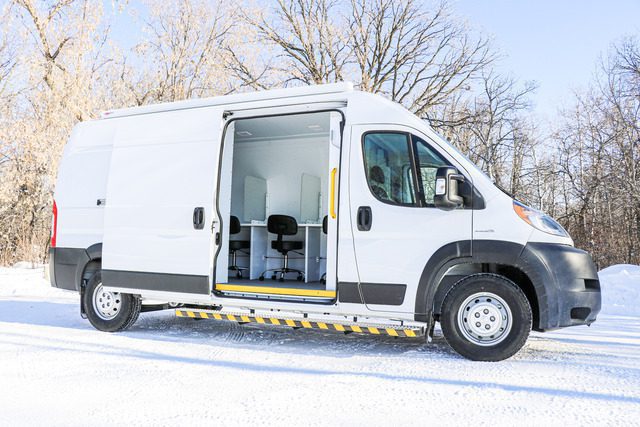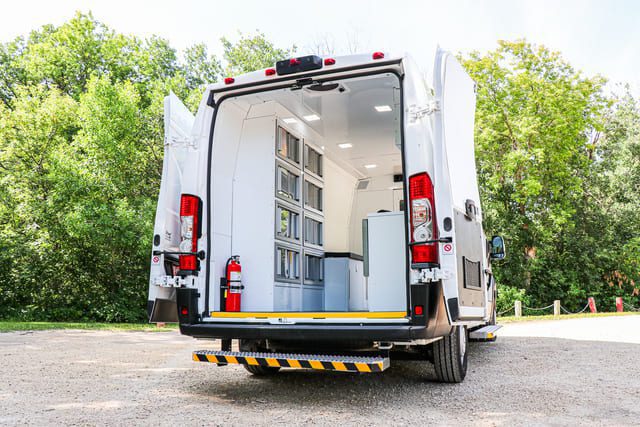Knowing how to properly secure a wheelchair into a van is one of the most important steps to providing safe transportation for your clients.
Most wheelchair transportation injuries are the result of improper wheelchair securement–simple mistakes such as attaching the restraint to a removable part of the wheelchair, or making the restraints too tight to the point where you cut off the blood circulation of the passenger.
It’s no surprise then to learn that proper wheelchair securement can save lives and prevent serious injuries.
This means that knowing the proper steps toward securing a wheelchair into a van–and by extension, securing the safety of your clients and the success of your organization–is extremely important.
You have to ensure your staff are trained on how to secure a wheelchair into a van before transporting wheelchair passengers.
And that’s why in this article, you’ll learn what wheelchair restraints are and how they work, how to secure a wheelchair into a van using the steps below*, and some do’s and don’ts when it comes to keeping your passengers safe.
But before you know the 9 steps to securing a wheelchair into a van, you need to know what a wheelchair restraint system actually is.
*Please note: these instructions are to be used as a guide only, and you should consult your mobility van supplier for instructions that are specific to your wheelchair restraint equipment. The following information explains how to use retracting wheelchair restraints such as the AMF Protektor system.
Wheelchair restraint systems–what they are, how they work

Accessible vans are designed to transport wheelchairs that are secured using specialized equipment called wheelchair restraints.
Wheelchair restraints prevent the wheelchair from moving during transport. The restraint system is built directly into the van floor to keep the wheelchair in place.
Not securing a wheelchair before transport will result in the wheelchair moving around while the van is in motion–which is extremely dangerous and unsafe while driving.
What happens if the driver takes a sharp turn, makes a sudden stop, or crashes? People will get hurt. Wheelchair restraints stop this from happening.
The main kind of wheelchair securement is a four-point restraint system. It comes with four straps/retracting belts with hooks, shoulder belts, and lap belts.
Read on to learn how to use a four-point restraint system.
How to secure a wheelchair into a van (9 steps)
Follow the steps below to safely secure a wheelchair into a van.
1. Bring the wheelchair into the van, ensuring the passenger is facing towards the front of the van (in a side entry van, you may need to turn the wheelchair to face the front). Position the wheelchair in the correct location for transport.
2. Apply the wheelchair brakes. If the wheelchair is powered, turn the power off.
3. Using one of the four restraints, secure it into the floor at one of the four corners of the wheelchair (two at the front, two at the back).
4. Extend the belt to hook it onto the frame of the wheelchair. Do not attach the restraint to removable parts of the wheelchair such as arm rests or leg rests. The restraint strap should be at a 45° angle.
5. Inspect the straps for any twists, and straighten these before transport. Do not cross or overlap any restraints.
6. Repeat steps 3 and 4 for the remaining restraints
7. Tighten the restraints using the retractor’s tightening knob to ensure the wheelchair is secured and cannot move. If your vehicle comes with ratchet-style restraints, carefully tighten the straps to prevent damage from overtightening.
8. Secure the lap belt over the passenger’s pelvic area. The strap should be secured into the floor at a 45° angle.
9. Secure the shoulder restraint belt over the passenger’s hip and shoulder. Ensure that it is not too tight at the passenger’s neck.
This belt should resemble a vehicle’s seat belt by extending from the passenger’s hip to the opposite side shoulder. Check out this related article from BraunAbility that describes how to use different kinds of wheelchair restraints properly.
Now that you know the 9 steps to securing a wheelchair into a van properly, you should know some do’s and don’ts that can help prevent you from making any errors.
How to secure a wheelchair into a van–do’s and don’ts
Follow these do’s and don’ts to make sure you’re securing a wheelchair into your van safely.
Securing a wheelchair into a van–do’s
Practice following these requirements to ensure your passengers are safe:
- Always face the wheelchair passenger forward
- Check that the lap and shoulder belts do not restrict passenger movement/blood flow
- Check that the wheelchair restraints are tight enough so that the wheelchair will not shift or twist when the vehicle is in motion
Securing a wheelchair into a van–don’ts
Avoid these mistakes to ensure your passengers are safe:
- Do not cross or overlap restraints
- Do not secure the wheelchair passenger facing sideways or backward
- Do not attach restraints to removable parts of the wheelchair such as arm rests or leg rests
Once again, please note that these instructions are to be used as a guide only. You should consult your mobility van supplier for instructions that are specific to your wheelchair restraint equipment.
Your next steps to securing a wheelchair into a van
You came to this article to learn how to secure a wheelchair into a van to make sure your passengers are traveling safely.
Now, you know what wheelchair restraints are and how they work, how to secure a wheelchair into a van using 9 steps, along with some do’s and don’ts when it comes to keeping your passengers safe.
For more information on passenger safety in wheelchair vans, talk to a MoveMobility expert now.
Or, check out these related articles for more information on wheelchair vans:
- How Much Does a Wheelchair Van Cost?
- Full Size Wheelchair Vans vs. Minivans: Which is Right for You?
- How to Choose the Wheelchair Van That’s Right for You (11 Steps)






